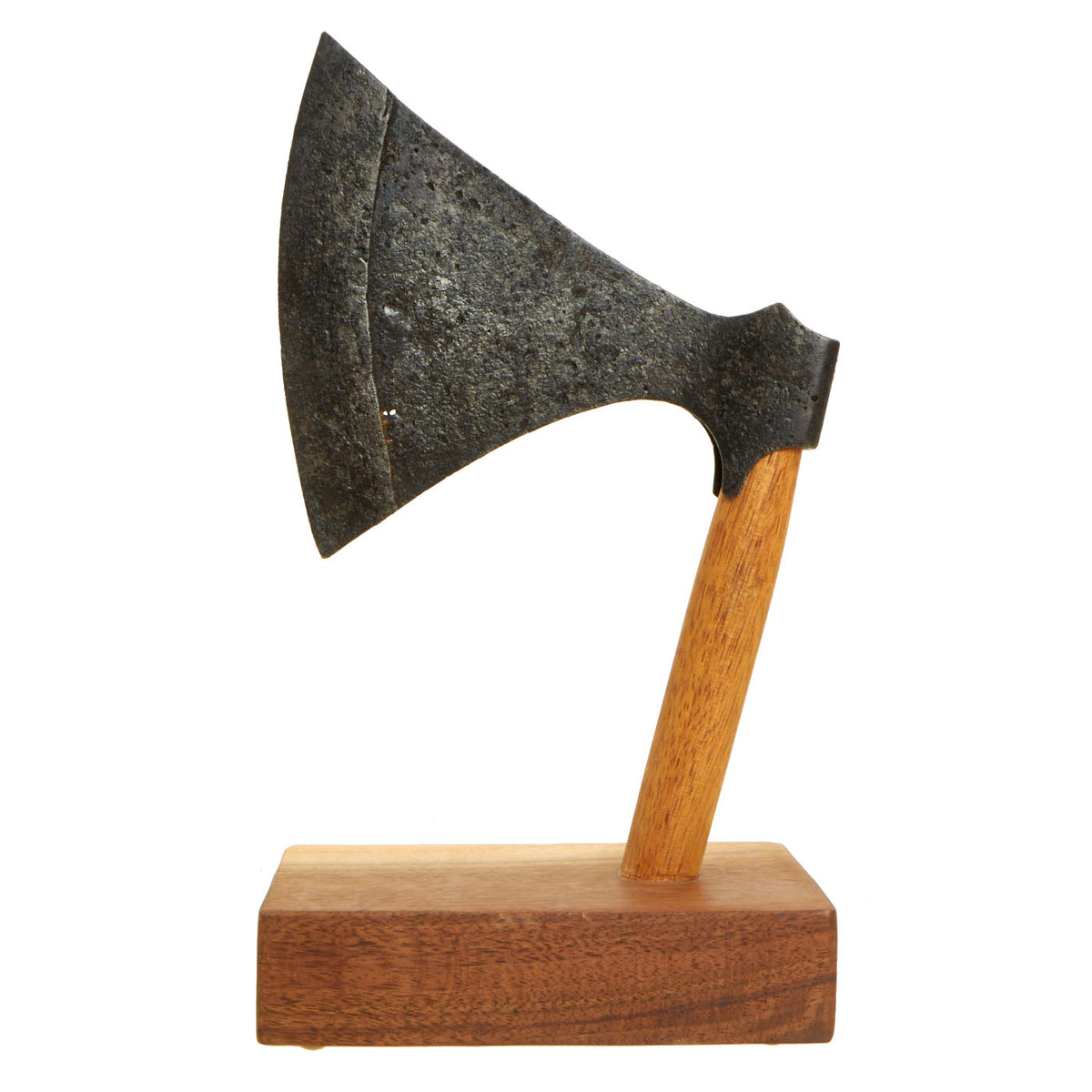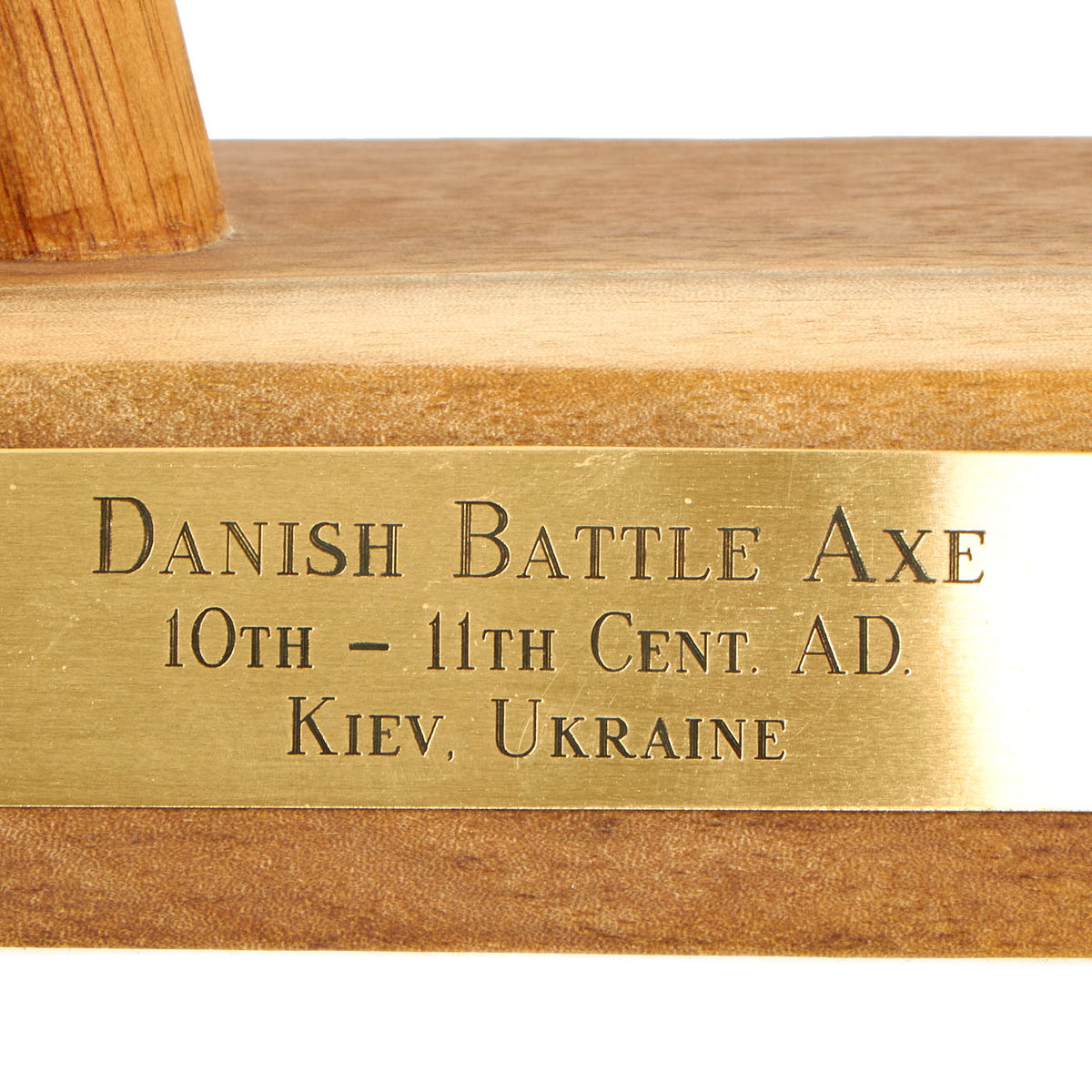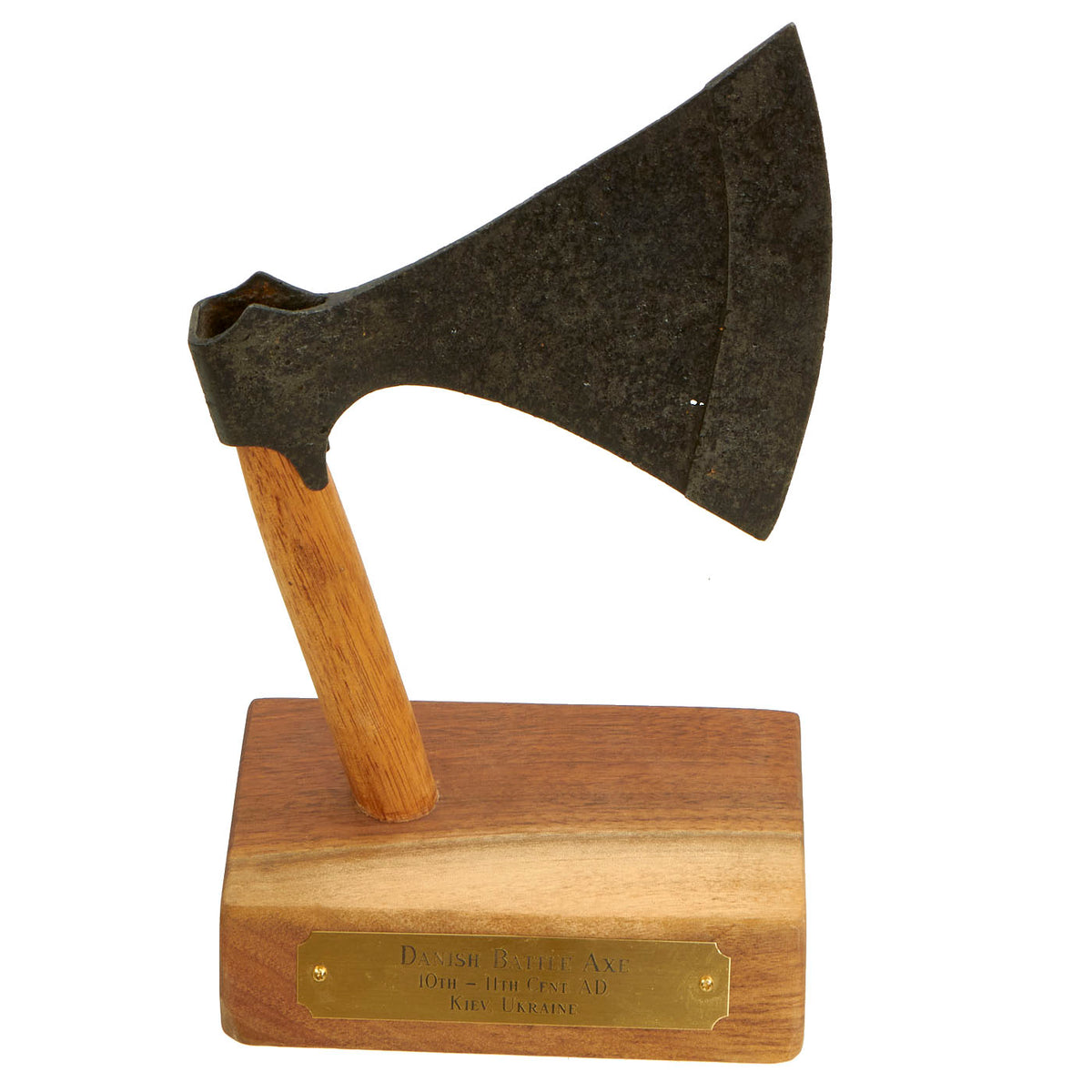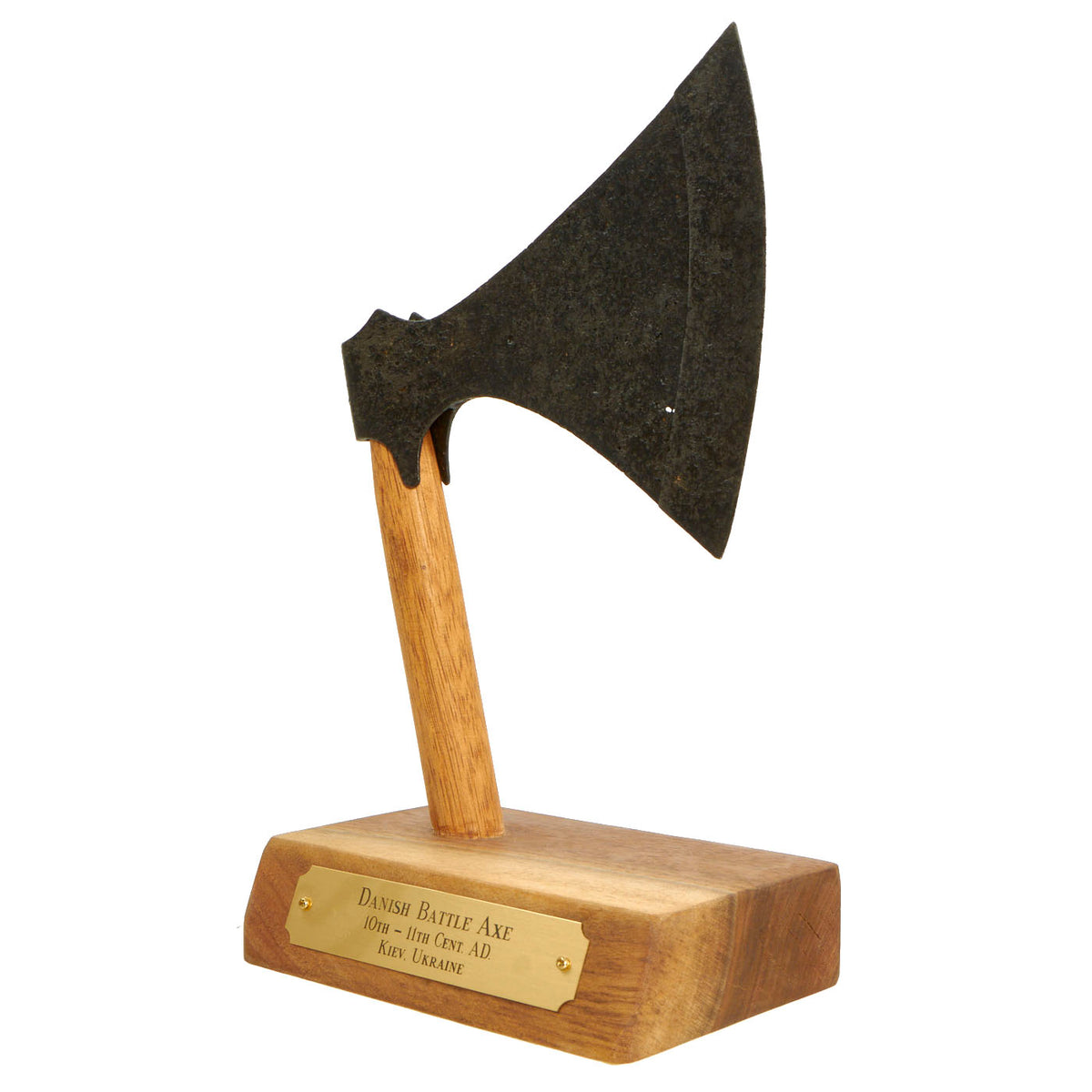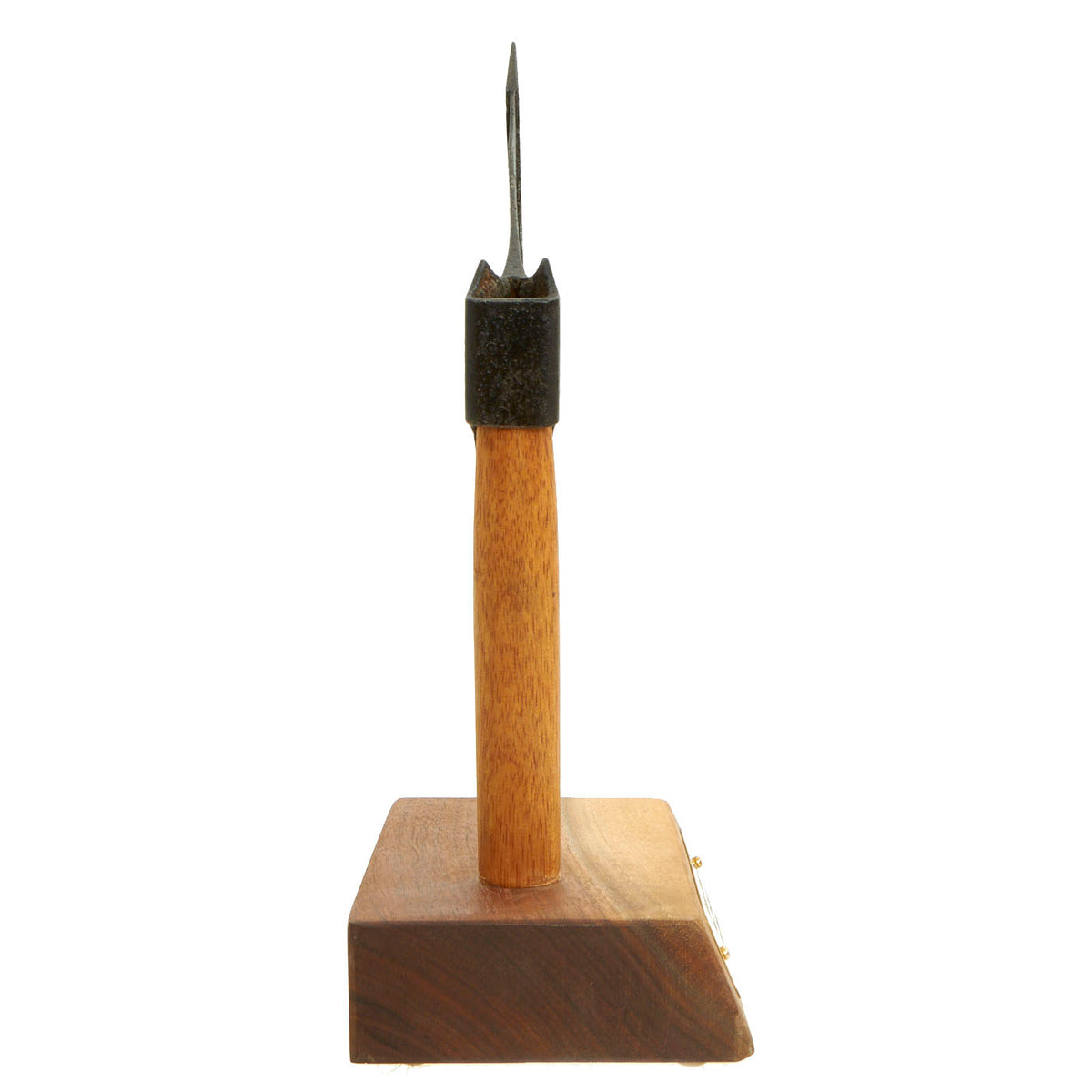Original 10th – 11th Century Dane Viking Battle Axe Head With Display Stand – Excavated in Kyiv, Ukraine Original Items
$ 1.895,00 $ 473,75
Original Item: Only One Available. The Dane axe is an early type of battle axe, primarily used during the transition between the European Viking Age and early Middle Ages. Other names for the weapon include English long axe, Danish axe, and hafted axe.
Most axes, both in period illustrations and extant artifact, that fall under the description of Danish axe possess type L or type M heads according to the Petersen axe typology.[1] Both types consist of a wide, thin blade, with pronounced “horns” at both the toe and heel of the bit. Cutting surfaces vary, but is generally between 20 and 30 cm (8 and 12 in). Type L blades tend to be smaller, with the toe of the bit swept forward for superior shearing capability. Later type M blades are typically larger overall, with a more symmetrical toe and heel.
The blade itself was reasonably light and forged very thin, making it superb for cutting. The thickness of the body on top of the edge is as thin as 2 mm. Many of these axes were constructed with a reinforced bit, typically of a higher carbon steel to facilitate a harder, sharper edge. Average weight of an axe this size is between 1 and 2 kg (2.2 and 4.4 lb). Proportionally, the long axe has more in common with a modern meat cleaver than a wood axe. This complex construction (i.e. forged thin and incorporating a harder type of steel near the edge) results in a lively and quick weapon with devastating cutting ability.
Based on period depictions, the haft of a longaxe for combat was usually between approx. 0.9 and 1.2 m (3.0 and 3.9 ft) long, although Dane axes used as status symbols might be as long as 1.5 to 1.7 m (5 to 5½ ft). Such axes might also feature inlaid silver and frequently do not have the flared steel edge of a weapon designed for war. Some surviving examples also feature a brass haft cap, often richly decorated, which presumably served to keep the head of the weapon secure on the haft, as well as protecting the end of the haft from the rigors of battle. Ash and oak are the most likely materials for the haft, as they have always been the primary materials used for polearms in Europe.
This is a wonderful example of the “Dane Ax” and comes with a lovely display stand with informative plaque on the front!
DANISH BATTLE AXE
10TH – 11TH CENT. AD.
KIEV, UKRAINE
A wonderful display piece to add to your collection!
Dimensions
Axe Head: 6 ½” x 5 ½”
Stand Height: 8 ½”
Base Measurements: 6” x 6” x 3 ½”
Through the course of the 9th–11th centuries, the Dane axe began to gain further popularity outside of Scandinavia, either through Viking trade or influence or independent developments; such as England, Ireland and Normandy. Historical accounts may depict the Dane axe as the weapon of some of the warrior elite in this period, such as the Huscarls of Anglo-Saxon England. In the Bayeux tapestry, a visual record of the ascent of William the Conqueror to the throne of England, the axe is almost exclusively wielded by well armored huscarls. These huscarls formed the core bodyguard of King Harold at the Battle of Hastings. A Dane axe, perhaps King Edward’s, is offered to Harold before he is crowned. The Bayeux Tapestry also depicts a huscarl cleaving a Norman knight’s horse’s head with one blow.[3] The Dane axe is also known to have been used by the Varangian Guard, also known as pelekyphoros phroura (πελεκυφόρος φρουρά), the “axe-bearing guard”. One surviving ivory plaque from the 10th century Constantinople depicts a Varangian holding an axe that is at least as tall as its wielder.
Although the name appears to indicate Scandinavian heritage, the Dane axe is thought to be named because of its popularity in Scandinavia as opposed to its origin. It became widely used throughout Europe from the 10th century, with axes gaining acceptance as a knightly weapon not long after; albeit not achieving the status of the sword. They also began to be used widely as an infantry polearm, with the haft lengthening to about 1.8 metres (6 ft). The 13th and 14th centuries also saw form changes, with the blade also lengthening, the rear horn extending to touch or attach to the haft. The lengthened weapon, especially if combined with the lengthened blade, was called a sparth in England. Some believe this weapon is the ancestor of the halberd.
While the use of the Dane axe continued into the 14th. century, axes with an armour piercing back-spike and spear-like spike on the fore-end of the haft became more common, eventually evolving into the pollaxe in the 15th century. The simple Danish axe continued to be used in the West of Scotland and in Ireland into the 16th century. In Ireland, it was particularly associated with gallowglass mercenaries.
Fast Shipping with Professional Packaging
Thanks to our longstanding association with UPS FedEx DHL, and other major international carriers, we are able to provide a range of shipping options. Our warehouse staff is expertly trained and will wrap your products according to our exact and precise specifications. Prior to shipping, your goods will be thoroughly examined and securely secured. We ship to thousands clients each day across multiple countries. This shows how we're dedicated to be the largest retailer on the internet. Warehouses and distribution centres can be located throughout Europe as well as the USA.
Note: Orders with more than one item will be assigned a processing date depending on the item.
Before shipping before shipping, we'll conduct a thorough inspection of the items you have ordered. Today, the majority of orders will be delivered within 48 hours. The delivery time will be between 3-7 days.
Returns
The stock is dynamic and we cannot completely manage it because multiple stakeholders are involved, including our factory and warehouse. So the actual stock may alter at any time. It's possible that you may not receive your order once the order has been made.
Our policy is valid for a period of 30 days. If you don't receive the product within 30 days, we are not able to issue a refund or an exchange.
You can only return an item if it is unused and in the same state as the day you received it. You must have the item in its original packaging.
Related products
Uncategorized
Uncategorized
Uncategorized
Uncategorized
Uncategorized
Uncategorized
Uncategorized
Uncategorized
Uncategorized
Armoured Fighting Vehicles of the World: AFVs of World War One (Hardcover Book) New Made Items
Uncategorized
Angolan Rebel 1970s era 60mm Inert Display Mortar from Angolan Civil War Original Items
Uncategorized
Uncategorized
Uncategorized
Uncategorized
Uncategorized
Uncategorized
Uncategorized
Uncategorized
Armored Burgonet Helmet & Polearm from Scottish Castle Leith Hall Circa 1700 Original Items
Uncategorized
Band of Brothers ORIGINAL GERMAN WWII Le. F.H. 18 10.5cm ARTILLERY PIECE Original Items
Uncategorized

